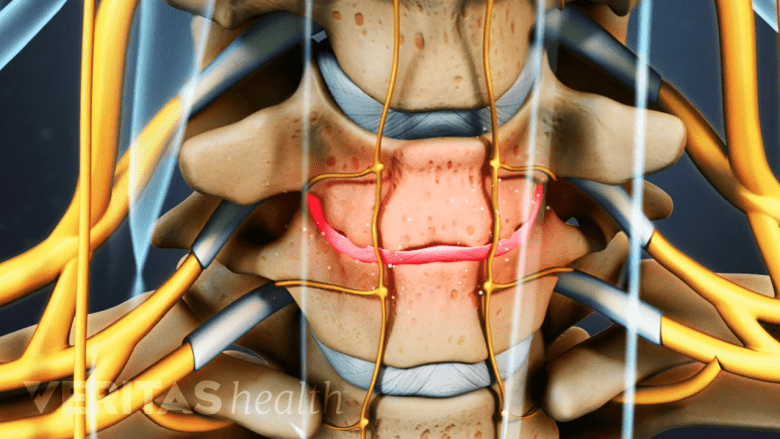When a person has degeneration in the cervical spine, it is likely that the degeneration is occurring in the disc(s) as well as in nearby facet joints. While it is possible for some facet joint degeneration to occur without associated disc degeneration, current medical literature indicates that disc degeneration usually begins before facet joint degeneration.1Bajwa NS, Toy JO, Young EY, Cooperman DR, Ahn NU. Disk degeneration in lumbar spine precedes osteoarthritic changes in hip. Am J Orthop. 2013; 42(7):309-12.,2Butler D, Trafimow JH, Andersson GB, McNeill TW, Huckman MS. Discs degenerate before facets. Spine (Phila Pa 1976). 1990; 15(2):111-3.
In This Article:
Healthy Cervical Disc Composition

Cervical discs have a tough outer layer and a soft gel-like inner layer.
Each cervical disc is comprised of a protective outer layer, called the annulus fibrosis, and a softer, gel-like inner layer, called the nucleus pulposus. These two layers work in concert to cushion adjacent vertebral bones and prevent them from grinding together during neck movements.
Both the outer layer and inner layer of the disc are mostly water, but the outer layer has tougher collagen. Between each disc and vertebra is the vertebral end plate, which is a thin spongy bone material that helps facilitate the flow of nutrients from the vertebral bone into the disc.
Degenerative Disc Disease

Cervical degenerative disc disease occurs when the disc begins to break down.
As a disc ages over time, it loses its ability to absorb and hold water, making it more susceptible to tears and injury. One study estimated that a healthy disc is about 80% water at age 10 and goes down to about 70% water by age 70.3Czervionke L. Degenerative disc disease. In: Czervionke L, Fenton D. Imaging Painful Spinal Disorders, 1st ed. Philadelphia, PA: Elsevier Saunders; 2011; Chapter 17. However, the rate at which a person’s discs lose water can vary greatly, and for some it can go much faster.
When the annulus fibrosis gets small tears, the nucleus pulposus starts to seep closer to the disc’s edge. As a result, the disc loses some height and may bulge outward more. Since the interior of the disc has no direct blood supply, it cannot heal itself like bone or muscle, and thus a vicious cycle can begin. When a disc experiences hydration loss and gets tears that lead to more tears and hydration loss, it is known as degenerative disc disease. (This condition is not technically a disease, but rather a degenerative process.)
With aging, the vertebral end plate becomes harder and more brittle, allowing less and less diffusion of nutrients across it into the disc. In some cases, damage to a vertebral end plate can occur, which makes it even harder for nutrients to get to the disc and further exacerbates the degenerative process. Vertebral end plate degeneration may happen before disc degeneration or in conjunction with it. The exact role that vertebral end plates play in disc degeneration is still being researched.4Moore RJ. The vertebral endplate: disc degeneration, disc regeneration. Eur Spine J. 2006; 15(Suppl 3): 333–7.
See Cervical Degenerative Disc Disease Symptoms and Diagnosis
Structural Problems Caused by Degenerating Discs

Disc degeneration can result in the leakage of the inner gel-like substance, leading to herniation.
As a cervical disc loses height due to degeneration, it no longer maintains the normal spacing between the adjacent vertebrae. This reduced spacing can cause the vertebral bodies to become closer together and can lead to problems, such as:
- Adding more stress on nearby facet joints, which may cause or exacerbate facet joint degeneration (cervical osteoarthritis).
- Decreasing the size of foramina (bony tunnels where nerve roots exit the spinal canal), which could increase the likelihood for a pinched nerve from cervical foraminal stenosis, bone spurs (osteophytes) or even small disc herniations.
See Cervical Herniated Disc Video
As the disc further degenerates, it can become herniated if the nucleus pulposus leaks through a complete tear in the annulus fibrosis. The nucleus pulposus contains inflammatory proteins that may cause pain if they come in contact with nerves in the outer annulus fibrosis (discogenic pain), push against nearby nerve root (cervical foraminal stenosis), or compress the spinal cord (cervical stenosis).
- 1 Bajwa NS, Toy JO, Young EY, Cooperman DR, Ahn NU. Disk degeneration in lumbar spine precedes osteoarthritic changes in hip. Am J Orthop. 2013; 42(7):309-12.
- 2 Butler D, Trafimow JH, Andersson GB, McNeill TW, Huckman MS. Discs degenerate before facets. Spine (Phila Pa 1976). 1990; 15(2):111-3.
- 3 Czervionke L. Degenerative disc disease. In: Czervionke L, Fenton D. Imaging Painful Spinal Disorders, 1st ed. Philadelphia, PA: Elsevier Saunders; 2011; Chapter 17.
- 4 Moore RJ. The vertebral endplate: disc degeneration, disc regeneration. Eur Spine J. 2006; 15(Suppl 3): 333–7.

